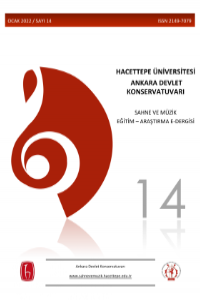BAKIR VE YAYLI ÇALGILARIN BAKTERİ KOLONİZASYONUNA YÖNELİK ÇÖZÜMLER
İnsanlar hayatının değişik aşamalarında, farklı yer ve zamanlarda mikroorganizmalarla sürekli olarak karşı karşıya gelmektedir. Bu durum müzisyenler açısından değerlendirildiğinde; bağışıklık sisteminin zayıflaması, yaş faktörü, geçirilmiş olunan hastalıklar, yaşanan diğer sağlık problemleri gibi nedenler, sanatçının sanatını icrasında kullandığı enstrümanlarda yaşayan mikroorganizmaların kişide hastalık oluşturmasında büyük rol oynadığı gerçeğini ortaya çıkarmaktadır. Bakır enstrümanların içine soluduğumuz nefes, içindeki nemli ortam dolayısıyla nemli iç mekân iklimi taşıyan partiküllerin yoğunlaşmasından kaynaklanan mikrobiyolojik bir ortamın hazırlanmasına yol açmaktadır.
Örnekler %5 koyun kanlı Columbia agar ve EMB agara ekilerek 24-48 saat 36 °C’de normal atmosfer şartlarında inkübe edilmiştir. İnkübasyon süresi sonunda üreyen kolonilerden saf kültür alınarak MALDI-TOF MS (Bruker Daltonics, ABD) ile tiplendirilmiştir. Fırça, silme bezi, Terrycloth, esnek fırça tutuculu temizleme çubuğu, Moleküler biyoloji’de kullanılan çözelti (tıp sektöründen temizlik malzemeleri), Antimikrobiyal Su Bazlı Solüsyon kullanılmıştır. Alınan keman örneklerinde en sık S. epidermidis, S. hominis ve S. aureus olmak üzere Gram-pozitif koklar ürerken, trombonların uç kısmından alınan örneklerde daha çok non-fermentatif Gram-negatif çomakların ürediği gözlenmiştir. İlk defa tarafımızca üretimi desteklenen ve içeriği su bazlı olan temizleme solüsyonu kullanılmıştır. Yaylı ve Bakır saz çalan müzisyenlere önerilebilir.
Anahtar Kelimeler:
Bakır çalgılar, yaylı çalgılar, bakteri kolonizasyonu, interdisipliner yaklaşım
POSSIBLE SOLUTIONS FOR MICROBIOLOGICAL CONTAMINATION OF BRASS AND STRING INSTRUMENTS
We humans are constantly confronted with microorganisms. In all situations, in all locations and at any time. In the case of musicians, the bacterial colonies in and around a music instrument can contribute considerably to the development of disorders or disease patterns when the immune system is weakened.In the warm and humid interior climate of brass instruments, created by condensing breath humidity and introduced particles, a microbiological climate quickly grows. The air partially inhaled through the instrument brings brass instruments into contact with these germs, which can pose health risks.
Samples were added to 5% sheep blood Columbia Agar and EMB Agara and incubated under normal atmospheric conditions at 24-48 hours 36 °C. After incubation, pure culture was taken from the reproducing colonies and determined with MALDI-TOF MS (Bruker Daltonics, USA). Cleaning methods were Brush, Wipe Terrycloth, flexible cleaning rod with brush attachment, (cleaning agent from the medical industry) and antimicrobial water based solution. In the samples taken from violin chinrests the most commonly detected bacteria were S. epidermidis, S. hominis ve S. aureus and Gram-pozitif. In samples from brass instruments, non-fermentatif Gram-negatif bacteria were detected more frequently. For the first time an antimicrobial water based solution stained by us was used. A strong bacteria reducing result could be detected, so musicians who play string or wind instruments are recommended.
Keywords:
Brass instruments, string instruments, microbial colonization, interdisciplinary approach,
___
- A. A, F. (1981:27). Allergic contact dermatitis in a violinist. The role of abietic acid--a sensitizer in rosin (colophony)--as the causative agent. Cutis, 466-473.
- AA, F. (1993:51). Allergic contact dermatitis from musical instruments. Curtis, 75-76.
- Catalogue of Microorganisms. (2020, May 1). http://gcm.wfcc.info/ adresinden alındı
- Deveci, N., Gürkan, N., Belet, N., & Baysal, S. (2017). Sphingomonas paucimobilis: An Uncommon Cause Of Meningitis J. Journal of Pediatric Infection, 124-128.
- Gambichler, T., Uzun, A., Boms, S., Altmeyer, P., & Altenmüller, E. (2008;58(4)). Skin conditions in instrumental musicians: a self-reported survey. Contact Dermatitis. Contact Dermatitis, 217-222.
- Glass, R., Conrad, R., Kohler, G., & Bullard, J. (2011;59). Evaluation of the microbial flora found in woodwind and brass instruments and their potential to transmit diseases. Gen Dent., 100-109.
- Metersky, M., Bean, S., & Meyer, J. (2010;138(3)). Trombone player's lung: a probable new cause of hypersensitivity pneumonitis. Chest, 754‐756.
- Mobley, J., & Bridges, C. (2016). Wind Ensemble Infectious Disease Risks: A Microbiological Examination of Water Key Liquids in Brass Instruments. County Department of Public Health, Sinton, Texas, Chair, Department of Music, Del Mar College, Corpus Christi, Texas, 6-11.
- Moller, J., Hyldgaard, C., Kronborg-White, S., Rasmussen, F., & Bendstrup, E. (2017). Hypersensitivity pneumonitis among wind musicians - an overlooked disease? European clinical respiratory journal,4.
- Onmeda . (tarih yok). https://www.onmeda.de/krankheitserreger/ adresinden alındı
- Peachy, R., & Matthews , C. (1978). "Fiddler's Neck". Br. J. Dermatol, 669-674.
- Rimmer, S., & Spielvogel, R. (1990;22). Dermatologic problems of musicians. J Am Acad Dermatol, 657-663.
- Robert Koch-Institut (RKI). (tarih yok). https://www.rki.de/DE/Home/homepage_node.html;jsessionid=414467EDF011A42C6BE3D89DFF7EB939.internet062 adresinden alındı.
- Stern, J. B. (1979). The Edema of Fiddler's Neck. Journal of the American Academy of Dermatology, 538-540.
- Strehlein, M., Wirmer, J., Schmid-Eisenlohr, E., & Daschner, F. (2004). Studie Weist antimikrobielle Wirkung von Kiefernkernholz gegen Erregern von Krankenhausinfektionen. Holz-Zentralblatt, 951.
- Tennstedt, D., Cromphaut, P., Dooms-Goossens, A., & Lachapelle, J. (1979). Dermatoses of the neckaffecting Violin and Viola players. Dermatosen in Beruf und Umwelt, 165-169.
- Vandamme, P., & Coenye, T. (2004;54). Taxonomy of the genus Cupriavidus: a tale of lost and found. Int J Syst Evol Microbiol, 2285-2289.
- Başlangıç: 2015
- Yayıncı: Hacettepe Üniversitesi
Sayıdaki Diğer Makaleler
SOSYAL ÖĞRENME KURAMI İLE FLÜT DERSLERİNİN NİTELİĞİ ARTIRILABİLİR Mİ?
BAKIR VE YAYLI ÇALGILARIN BAKTERİ KOLONİZASYONUNA YÖNELİK ÇÖZÜMLER
Aslı ÖZSOY KÖRNER, Peter KÖRNER
BİR DEBUSSY PRELÜDÜNE ANALİTİK BAKIŞ: VOILES
CAMILLE SAINT SAENS’IN SAMSON ve DALILA OPERASININ “DANS BAKANAL” BÖLÜMÜNDE MAKAM MÜZİĞİ UNSURLARI
Doğan ÇAKAR, Mehmet Korhan ILGAR
FLÜT ÇALMA SANATINDA NEFES TEKNİĞİNİ GELİŞTİRİCİ ÇÖZÜMLER
BİR DEDE EFENDİ ŞARKISINDA MOTİF-YAPI
BİR HİKÂYE ANLATICISI : JOHN CRANKO
SKRİABİN OP. 42 ETÜTLERİN SAYISAL YOĞUNLUK VE SES ALANI ANALİZLERİ
